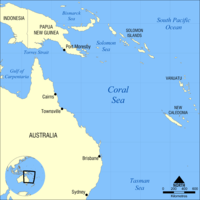
Photo from wikipedia
Abstract Areas of the Northwest (NW) Pacific have been investigated in the last century from board of the Russian RV Vityaz. During the past decade intensive collaboration between German and… Click to show full abstract
Abstract Areas of the Northwest (NW) Pacific have been investigated in the last century from board of the Russian RV Vityaz. During the past decade intensive collaboration between German and Russian scientists has yielded a wealth of precious material partly from unknown areas. The samples are comparable and were retrieved using comparative epibenthic sledge (EBS) deployments following a standardized sampling approach. In the present paper we investigate a large number of EBS samples (76) from a widespread geographic area. Macrofaunal high-taxonomic-level taxa composition is analysed based on four joint expeditions performed between 2010 and 2016, led by German and Russian teams in the NW Pacific, the Sea of Japan, the Sea of Okhotsk, and the Kuril-Kamchatka Trench and adjacent abyssal plain. In total, 410,279 invertebrates were sampled with an epibenthic sledge and more than half of all animals were collected in the Sea of Japan (240,803 individuals). Arthropods, represented by crustaceans, were dominant throughout all geographic areas (199,044 ind.), followed by Annelida (84,751 ind.), Echinodermata (46,317 ind.), and Mollusca (43,391 ind.). Within these phyla, eleven taxa occurred with more than 10,000 individuals in the samples from all geographic areas. The most numerous were the Peracarida (104,139 ind., represented by Isopoda [42,511 ind.], Amphipoda [29,375 ind.], Cumacea [16,364 ind.], Tanaidacea [15,889 ind.]), followed by Polychaeta (84,751 ind.), Copepoda 76,496 ind., Bivalvia (36,286 ind.), Ophiuroidea (34,818 ind.), Nematoda (24,968 ind.), Ostracoda (11,304 ind.), and Holothuroidea (10,772 ind.). The pattern of occurrence per taxon varied between geographic areas. In general, Bivalvia and Holothuroidea were more frequently recorded from hadal stations, but no significant differences could be observed between geographic areas (Sea of Japan, Sea of Okhotsk, and open NW Pacific) at high level taxa (classes, subclasses, superorders) when community composition is compared and depth differences are taken into account. However, significant differences between all depth zones (p
Journal Title: Progress in Oceanography
Year Published: 2019
Link to full text (if available)
Share on Social Media: Sign Up to like & get
recommendations!